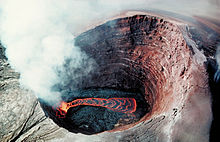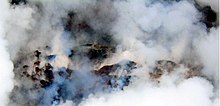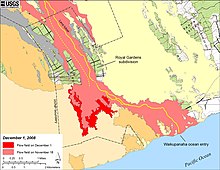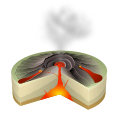Puʻu ʻŌʻō
| Puʻu ʻŌʻō | |
|---|---|
 |
Puʻu ʻŌʻō (often written Puu Oo, and IPA: [puʔu ʔoːʔoː] (roughly "poo-oo oh-oh")) is a cinder/spatter cone in the eastern rift zone of the Kīlauea volcano of the Hawaiian Islands. Puʻu ʻŌʻō has been erupting continuously since January 3, 1983, making it the longest-lived rift-zone eruption of the last two centuries. From 1983 through 1998, lava from Puʻu ʻŌʻō covered more than 97 km² (37 square miles).
Although the name is often translated as "Hill of the ʻŌʻō Bird" from Hawaiian, there is a different explanation of the Hawaiian appellation.[1] The word ʻŌʻō also means digging stick.[2] Because in Hawaiian legends the volcano goddess Pele uses her magic rod pāoa[3] to create volcanic pits,[4] this seems to be the intention for the naming. The cone was originally informally called "Puʻu O" by vulcanologists, who simply assigned letters to vents as they arose during the first part of the eruption.[5]
As of 1998, the eruption had claimed 181 houses, as well as a church, a store, the Wahaʻula Visitor Center, and many ancient Hawaiian sites, including the Wahaʻula heiau. The coastal highway has been closed since 1987, as lava flows covered 13 km (8 miles) to as great a depth as 25 m (80 ft). The eruption has added 544 acres (2.2 km²) of land to the island of Hawaiʻi.
Puʻu ʻŌʻō-Kupaianaha eruption
The Puʻu ʻŌʻō eruption began when fissures split the ground in the remote rainforest of the eastern rift zone. By June 1983, the activity had strengthened and localized to the Puʻu ʻŌʻō vent. Over the next three years, 44 eruptive episodes with lava fountains as high as 460 m (1500 ft) stopped traffic at points across east Hawaiʻi. The fallout of cinder and spatter from the towering lava fountains built a cone 255 m (835 ft) high. In July 1986, the conduit feeding magma to Puʻu ʻŌʻō ruptured, and the eruption abruptly shifted 3 km downrift to form the Kupaianaha vent. With the new vent came a new style of eruption: continuous, quiet effusion from a lava pond replaced the episodic high fountaining. Overflows from the pond built a lava shield—a broad, low hill shaped like an overturned wok.
In November 1986, lava from Kupaianaha reached the ocean, 12 km (7 miles) to the southeast, inundating the small community of Kapaʻahu in its path. For the next five years, much of the lava erupted from Kupaianaha streamed directly into the sea via a lava tube system that led from the lava pond.

In 1990, the eruption entered its most destructive phase when flows turned eastward and totally destroyed the villages of Kalapana and Kaimū. Kaimū Bay and Kalapana Black Sand Beach were also completely covered with lava. Over 100 homes were destroyed by the ever-broadening flow field in a nine-month period. New tubes diverted lava away from Kalapana early in 1991, and lava once again entered the ocean within the Hawaii Volcanoes National Park. The volume of lava erupted from Kupaianaha declined steadily through 1991, and in early 1992 the vent died. The eruption then returned to Puʻu ʻŌʻō, where flank vents on the west and southwest sides of the cone constructed a new lava shield. Soon lava tubes were feeding lava from the vents to the ocean, with few surface flows in between. The flank vents have held center stage ever since, with the exception of a two-month pause in activity early in 1997 that followed a brief fissure eruption in Nāpau Crater, a short distance southwest of Puʻu ʻŌʻō.
On the evening of January 29 1997, a series of earthquakes struck Kīlauea's east rift zone. Deep within the rift zone, magma was escaping from the conduit leading to the Puʻu ʻŌʻō vent, cutting off the supply to the ongoing eruption. The lava pond at Puʻu ʻŌʻō drained, and residents 10 miles (16 km) away heard a low, rumbling roar as the crater floor dropped 500 feet (150 m) and the west wall of the Puʻu ʻŌʻō cone collapsed. A few hours later, as magma found a new path to the surface, the ground cracked in nearby Nāpau Crater, and lava fountains lit up the night sky.
Recent Activity
The Puʻu ʻŌʻō cone is now in its twenty-fifth year and 57th eruptive episode. This is the largest volume of lava in the past five centuries to erupt from the volcano's east rift zone. For the last decade the eruption has flowed from flank vents on the south and west sides of the cone.
2007

As of January 2007, 3.1 cubic km of lava had covered 117 km2 (45 mi2) and added 201 hectares (500 acres) to Kīlauea's southern shore. The new shoreline is 15.6 km (9,7 miles) long. The lava flows have destroyed 189 structures and covered 14 km (8.4 miles) of highway with as much as 35 m (115 ft) of lava.
In 2007, after a cluster of earthquakes, activity in Puʻu ʻŌʻō subsided and the crater floor collapsed, with no incandescence visible in the crater after the end of August. Lava began emerging from a series of cracks in the northeast rift zone and spread slowly east and south as a perched flow, with slow advances of ʻaʻā. The flow spread mostly over flows of 1983-1986, with minor incursions into adjoining forest.
2008

In late July 2008, additional flows extended from the eastern vents of Puʻu ʻŌʻō and in October multiple new fissures opened along the length of the tube expanding into Royal Gardens Subdivision and also covering a large area of the Coastal Flats in November, 2008.
Footnotes
- ^ C. Heliker, D.A. Swanson, T.J. Takahashi: The Puʻu ʻŌʻō-Kūpaianaha Eruption of Kīlauea Volcano, Hawaiʻi: The First 20 Years. In: U.S. Geological Survey Professional Paper. 1676, 2003. Online Version
- ^ see Hawaiian Dictionaries
- ^ see Hawaiian Dictionaries
- ^ W. D. Westervelt: Hawaiian Legends of Volcanoes. G.H. Ellis Press: Boston 1916. p. 6. see How Pele came to Hawaii
- ^ M.O. Garcia, J.M. Rhodes, F.A. Trusdell, A.J. Pietruszka (1996). "„Petrology of lavas from the Puu Oo eruption of Kilauea Volcano: III. The Kupaianaha episode (1986-1992)"". Bulletin of Volcanology. 58 (5): 359–379. doi:10.1007/s004450050145.
{{cite journal}}: CS1 maint: multiple names: authors list (link)
References
- USGS Volcano Hazards Program: The Puʻu ʻŌʻō-Kupaianaha eruption: still flowing after all these years (public domain)
- U.S. Geological Survey fact sheet 144-02: The Puʻu ʻŌʻō-Kupaianaha eruption of Kīlauea Volcano, Hawaiʻi, 1983 to 2003 (public domain)

